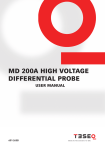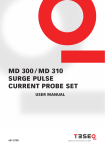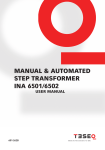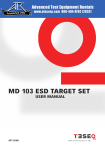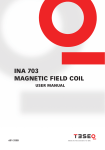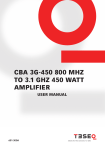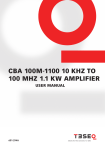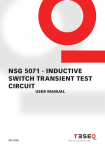Download 601-247B - MD 200 User Manual english.indd
Transcript
1 MD 200 High voltage differential probe User Manual 601-247B MD 200 High voltage differential probe User Manual MD 200 high voltage differential probe contentS 1 Safety terms and symbols 2Safety 3Description 4Installation 5Appearance 6 Technical specifications 7 Derating curve 8 Inspection procedure 9Cleaning 10 CE conformity 11Adresses 5 6 8 9 10 11 13 14 15 16 18 1Safety terms and symbols Terms used in this manual: WARNING: Warning statements identify conditions or practices that could result in injury or loss life. CAUTION: Caution statements identify conditions or practices that could result in damage to this product or other property. Symbols used on the product: Danger Protective Danger high voltage earth terminal refer to manual 5 6 2safety Study the following safety precautions to avoid injury and prevent damage to the probe or any products connected to it. Observe the maximum working voltage: To avoid any injury, do not use the probe above 2500 Vrms CAT II between each input lead and earth or above 5000 Vrms CAT II between two inputs. This voltage rating applies to both the 1:100 and 1:1000 settings. Must be earthed: The probe is earthed via the shell of the BNC connector together with an auxiliary earth connection and finally through the earth conductor of the power cable connected to the measuring instrument. Before making any connections via the input leads of the probe, ensure that the output BNC connector is attached to the BNC input connector of the measuring instrument and the auxiliary earth wire is connected to a solid earth point. Use fused test prods if necessary: If the probe is intended for use in measurements on circuits of INSTALLATION CATEGORY III, it should be used in combination with fused test prods. Do not operate without covers: To avoid electric shock or fire hazard, do not operate the probe with the covers removed. Do not operate in wet/damp conditions: To avoid the risk of electric shock, do not operate the probe in wet or damp conditions. Do not operate in an explosive atmosphere: To avoid injury or fire hazard, do not operate the probe in an explosive atmosphere. MD 200 high voltage differential probe Avoid exposed circuitry: To avoid injury, remove jewellery such as rings, watches, and other metallic objects. Do not touch exposed connections and components when power is present. Use a proper power source: Use four AA cells or a 6 VDC/200 mA mains adapter. Do not operate this probe from a power source that applies more than the specified voltage. Do not operated with a suspected fault: If you suspect there is damage to the probe, have it inspected by a qualified service engineer or return it to a Teseq service center without delay. 7 8 3Description By enabling a conventional oscilloscope to display and measure in-circuit waveforms that are referenced to high common mode voltages, the differential probe extends the measurement capability of that oscilloscope into the field of surge pulse measurements, in electronic power converters, inverters, motor speed controls, switch mode power supplies and many other applications. MD 200 high voltage differential probe 4Installation Simply plug the BNC output connector of the probe into the input of a general purpose oscilloscope or other measuring instrument, and connect the auxiliary earthing terminal to a proper earth point. The measuring instrument must have an earth reference. Install four AA cells or connect an appropriate mains adapter to the probe. a) Adjust the vertical offset (or position) on the measuring instrument input. b) Select the appropriate attenuation ratio. With signals below 700 V, switch the attenuation ratio to 1:100 in order to get higher resolution and less noise. Otherwise, set the attenuation ratio to 1:1000 with signals of up to 7000 V. To protect against electric shock, use only the accessories supplied with the probe. c) Connect the input to the circuit under measurement using the appropriate probe accessories. The probe is designed to carry out differential measurements between two points on the circuit under investigation. The probe is not intended for electrical insolation of the circuit under measurement or the measuring instrument. 9 10 5Appearance The differential probe is configured as shown below: B C A A Output lead: BNC connector and auxiliary earth lead for connection to an oscilloscope. B Input leads: The input leads of the differential probe must be plugged into the spring clips in order to ensure safe connection to the EUT. C Spring clip: For safe test point connection. MD 200 high voltage differential probe 6 technical specifications Attenuation ratios Bandwidth Accuracy Input impedance Max. input voltage – Differential range* – Common mode range* Output voltage – Max amplitude – Offset (typical) – Noise (typical) – Source impedance (typ) CMRR (typical) Operating temperature Storage temperature Operating humidity Storage humidity Power requirements Length of BNC lead Length of input lead Weight Dimensions (L x W x H) 1:100 and 1:1000 DC to 10 MHz (-3 dB) +/- 2% 10 MΩ/7 pF each side to ground ± 700 V (DC+ peak AC) or 5000 Vrms for 1:100 ± 7000 V (DC+ peak AC) or 5000 Vrms for 1:1000 ± 3500 V (DC+ peak AC) or 2500 Vrms for both 1:100 and 1:1000 ratios ±7 V (into 50 kΩ load or more) <±5 mV 0.9 mVrms 50 Ω -80 db at 50 Hz; -60 db at 20 kHz -10 to +40°C -30 to +70°C 25 to 85% rh 25 to 85% rh 4 x AA cells or 6 VDC/200 mA** 90 cm 60 cm 500 g 207 x 83 x 38 mm 11 12 * Voltage limit is the lower of the DC+ peak AC and rms values **a) The supplied voltage must be less than 12 V but more than 4.4 V otherwise the probe could be damaged or will not operate properly. b) Polarity is + inside and – outside. In the event of reversed polarity, a built-in circuit protects the probe so no danger or damage will occur. c) The power indicator on the panel will start to blink if the supply voltage falls too low. MD 200 high voltage differential probe 7 Derating curve 13 The derating curve for the absolute maximum input voltage in common mode is as follows: 15000 10000 5000 Voltage [Volt Vrms] 1000 500 100 50 10 1.0E+05 Frequency [Hz] 1.0E+06 1.0E+07 1.0E+08 14 8Inspection procedure a) Connect the BNC output connector to the input of a general pur-posed oscilloscope. b) Install four AA cells or connect an appropriate mains adapter to this probe. c) Set the oscilloscope input selector to DC and 1 V/div. Center the trace on the display. d) Connect the probe’s input clips to a pair of suitable mains power lines. e) Set the range on the probe to 1:1000. f) A 50 Hz/60 Hz sinewave of proper amplitude should be be displayed on the screen of the oscilloscope which shows that the probe is working properly. MD 200 high voltage differential probe 9cleaning Use a soft cloth to clean off any dirt. Take care not to damage the probe. Do not immerse the probe in water Avoid using abrasive cleansers Avoid using chemicals containing benzene or similar solvents 15 16 10CE Conformity MD 200 high voltage differential probe NOTES 17 Headquarters Teseq AG 4542 Luterbach, Switzerland T + 41 32 681 40 40 F + 41 32 681 40 48 sales @ teseq.com www.teseq.com Manufacturer Teseq AG 4542 Luterbach, Switzerland T + 41 32 681 40 40 F + 41 32 681 40 48 sales @ teseq.com China Teseq Company Limited T + 86 10 8460 8080 F + 86 10 8460 8078 chinasales @ teseq.com France Teseq Sarl T + 33 1 39 47 42 21 F + 33 1 39 47 40 92 francesales @ teseq.com Germany Teseq GmbH T + 49 30 5659 8835 F + 49 30 5659 8834 desales @ teseq.com Japan Teseq K.K. T + 81 3 5725 9460 F + 81 3 5725 9461 japansales @t eseq.com Singapore Teseq Pte Ltd. T + 65 6846 2488 F + 65 6841 4282 singaporesales @ teseq.com Switzerland Teseq AG T + 41 32 681 40 50 F + 41 32 681 40 48 sales @ teseq.com Taiwan Teseq Ltd. T + 886 2 2917 8080 F + 886 2 2917 2626 taiwansales @ teseq.com UK Teseq Ltd. T + 44 845 074 0660 F + 44 845 074 0656 uksales @ teseq.com USA Teseq Inc. T + 1 732 417 0501 F + 1 732 417 0511 Toll free +1 888 417 0501 usasales @ teseq.com © December 2010 Teseq® Specifications subject to change without notice. Teseq® is an ISOregistered company. Its products are designed and manufactured under the strict quality and environmental requirements of the ISO 9001. This To find your local partner within document has been carefully checked. Teseq®’s global network, please go to However, Teseq® does not assume www.teseq.com any liability for errors or inaccuracies.


















